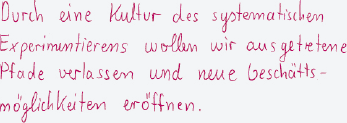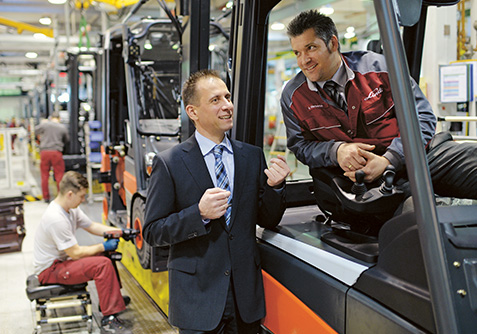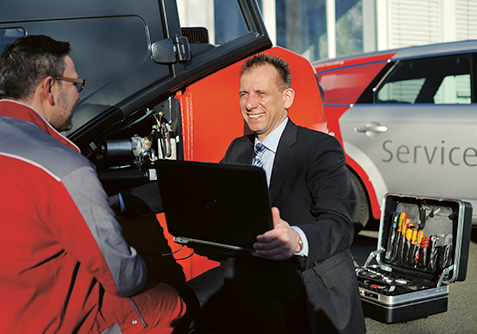Andreas Kistner doesn’t do well-trodden paths. In search of the next brilliant idea, he and his team love nothing more than going off the beaten track. Their goal: ensuring tomorrow is as successful as today.
Mr Kistner, as a runner you usually know the route to the finishing line before you set off – which must be quite different from your job as Head of Innovation Management?
At the end of the working day, I actually look forward to well maintained, well lit running tracks. At work things are different: I look for new ways of doing things and I like challenges. Even as a child I enjoyed trying things out when playing with Lego, and this passion has never left me. I basically grew up in the garage where I tinkered about with motorbikes. I got on a motorbike for the first time when I was eight, and I entered my first competition a year later. Now, I’m still involved in international motocross competitions as a scrutineer who carries out technical inspections of the motorcycles in use.
When you’re running you’re on your own. Are you also alone in your role as innovation manager?
Not at all. We work in cross-functional teams. Our areas of expertise are wide ranging and include sales, service, marketing, research & development and production. That’s extremely important, because we need to keep our eye on many areas, such as megatrends, new technologies, different customer groups and potential new customers, markets, competitors, our company, resources and, consequently, the environment. We give our employees the scope to think about the future, which is where our company’s success will lie. It is particularly important for our staff to be creative, passionate and daring, for them to work hard on their innovations, to think like business people and to be prepared to break completely new ground.
What makes changes into innovations?
Innovations are products, processes and business models that inspire customers, who are only prepared to spend money on genuine added value, which ultimately is what makes innovation – financially – successful. As well as improvements to products, which are often minor, it can also include new products, service optimisations, profitable payment models or new logistics management processes.
In terms of efficiency, Linde trucks are already the best – where do you plan to go next?
Resting on our laurels would not be good enough for us, and it’s also risky. Our ambition is to steadily produce innovations that result in progress for Linde Material Handling and our customers. The fundamentals for this are structured procedures and the use of appropriate methods. Most innovations then arise from experimentation, intensive teamwork and numerous iterations. Our intention in creating a culture of systematic experimentation is to get off the beaten track and open up new business opportunities.
How does that work in practice?
Today, we don’t know where we will be in 15 or 20 years’ time, or – in other words – what the world and our customers will be like then. Obviously, many factors will change and the speed of these changes will become ever greater as the world becomes even more complex. How will logistics systems and the flow of goods change? Will our customers still buy equipment in 15 year’s time, or will there be completely different payment models? It is important to analyse all these factors on an ongoing basis and to evaluate current and potential business opportunities with the upside and downside in mind – and then to take action at the right time.
-
Attractive market with growth profile above GDP.
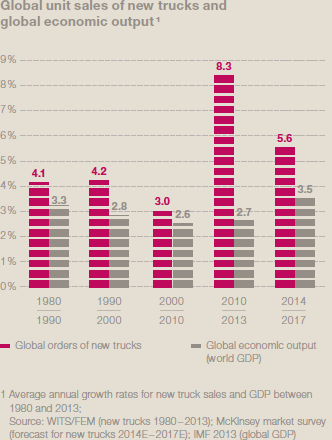
The KION Group operates in an attractive market that is growing faster than global economic output.
The worldwide market for industrial trucks grew at roughly 1.4 times the rate of the global economy between 1980 and 2013. Industry experts reckon that this pace is set to accelerate slightly over the period up to 2017.
This scenario is being driven by three global mega-trends:
- the industrialisation of the emerging markets,
- the advancing globalisation of world trade and, as a consequence, the increasing transportation of goods around the world,
- the growing fragmentation of supply chains and value chains: just-in-time logistics and purchases from online retailers create demand for the KION Group’s products and services.
-
A global leader– strong home base ...
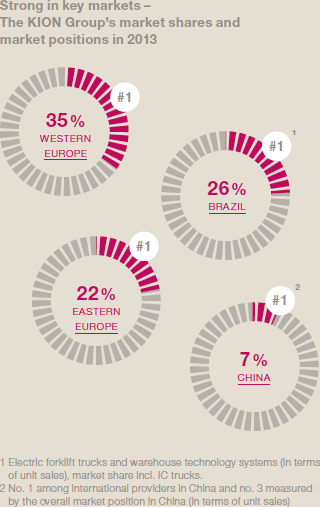
Measured in terms of new trucks sold, the KION Group is currently number one in the European market and number two in the market worldwide. And with a presence in more than 100 countries, the company is the world’s biggest specialist provider of materials handling trucks and associated services.
Our strong position in western Europe, where we have a market share of 35 per cent (2013), is the basis for the global expansion of the KION Group. The foundation of our business is stable in this region because of replacement purchases and a strong service business.
After plunging into a deep crisis, Europe’s market for industrial trucks is now recovering. Since 2010 the KION Group has benefited from this trend with a double-digit percentage increase in revenue in Germany and the rest of Europe.
-
... and well positioned in growth markets.
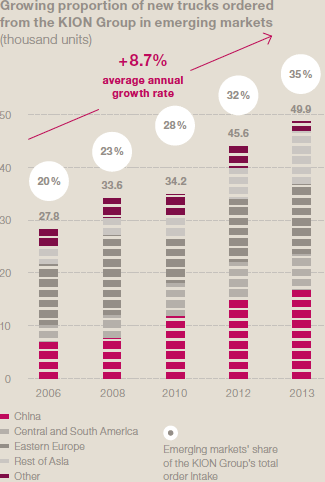
The KION Group’s leading position in emerging markets such as India, China, South America and eastern Europe means that it is excellently placed to fully exploit the growth opportunities available there. In 2013 the KION Group’s brand companies sold 35 per cent of their new trucks in emerging markets – and this proportion is set to rise sharply.
A case in point is China, which is the world’s largest individual market for the KION Group’s products. The Company has been firmly established here with its offering of development, production and services for more than two decades and is the leading non-domestic supplier. The KION Group is the third-largest player in this market, where it employs some 3,200 people. China is now the Company’s second-biggest market in terms of unit sales (behind only Germany).
-
Technology leadership drives premium positioning ...
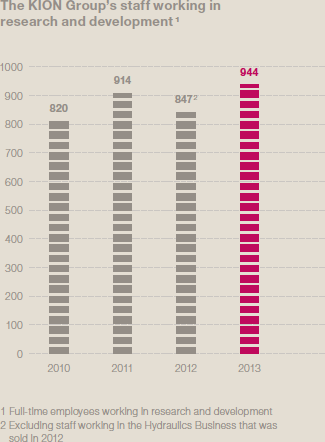
The KION Group is right in the vanguard when it comes to technology and innovation. By spending in excess of €114 million on research and development in 2013, the Company is a leader in its sector.
Over 900 people work at ten research centres in Europe, Asia and the Americas to devise forward-looking solutions; more than a quarter of them are based in China so that they are close to their market. This continuous R&D investment means that clients in all markets and segments can expect to have a fully customised range of trucks and services to choose from.
In 2013 the KION Group launched more than a dozen new trucks and truck families in the market, thereby providing added impetus for 2014, and a number of new products and services are set to be introduced this year as well.
-
... and customer value.
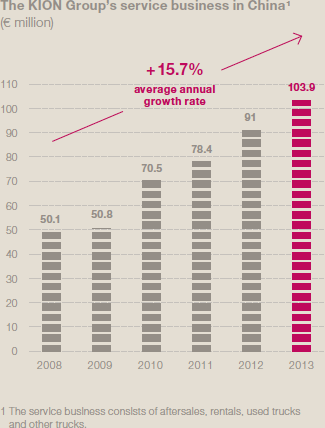
Customers of the KION Group particularly benefit from the industrial trucks’ good handling capacity and very low running costs throughout their lifecycle.
The cost benefits for customers mean that the KION Group can set prices at a level that enables it to achieve higher margins than its competitors. After all, personnel expenses and the cost of operating a truck over its lifecycle constitute a significant portion of the purchase price, especially in highly developed markets.
The proximity of the KION Group’s brand companies to their customers also ensures a high level of availability for the trucks. Around the world, around 12,900 inhouse and external service engineers work for the KION Group. This business offers considerable potential also outside of Europe: in China, revenue from services has risen substantially in recent years.
-
Robust integrated business model with high contribution from services.
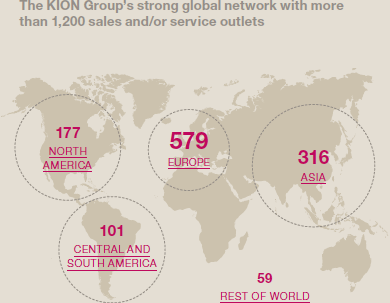
This provides the basis for the KION Group’s lasting business success. Customer services, truck rentals, used trucks and spare parts together contribute more than 40 per cent of revenue. This business is very resilient to fluctuations in the economic cycle. Moreover, it generates particularly good margins for the KION Group.
There are around 1.2 million KION trucks in use around the globe, forming a broad basis for a strong and integrated service business.
A comprehensive network of more than 1,200 sales and/or service outlets worldwide ensures that the KION Group is never far from its customers. This creates strong customer loyalty, which in turn offers more potential for growth and provides a lasting competitive advantage.
-
Strong profitability – well prepared for future value creation.
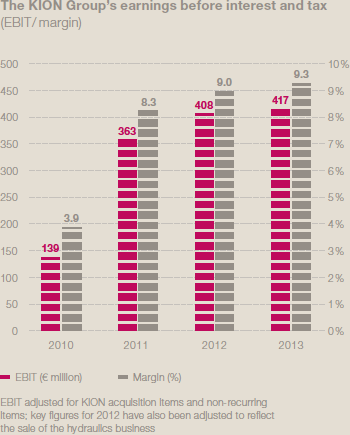
Constantly improving efficiency and profitability is a clear objective for the KION Group. Size and synergies – a combination that makes the KION Group stand head and shoulders above other truck manufacturers.
This involves collaborating on research and development, improving plant structures and fully exploiting the economies of scale created by a worldwide production network. Other areas of focus are the optimal use of shared, cross-brand modules and platforms and the ongoing expansion of the service business.
-
Highly motivated and qualified employees with proven track record.
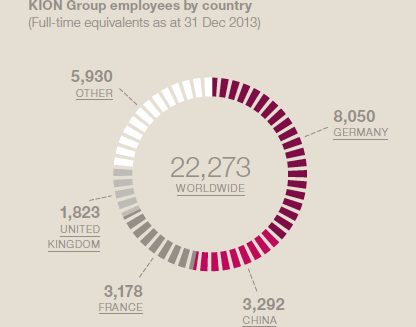
International, highly qualified and highly motivated: the KION Group’s more than 22,000 employees, who demonstrate dedication and creativity day in, day out, are both the heart and the backbone of the company.
Their hard work underpins the operational success of the company and ensures a strong financial performance. This was one of the key elements in the successful stock market flotation of the KION Group in June 2013.
The company’s growth strategy is reflected in the structure of the workforce. In 2013, the Group recruited extra staff for its service and sales operations and notably invested in new employees in the emerging markets and growth regions. The KION Group is increasingly hiring local management in all its markets in order to utilise their strong market knowledge and expertise.
